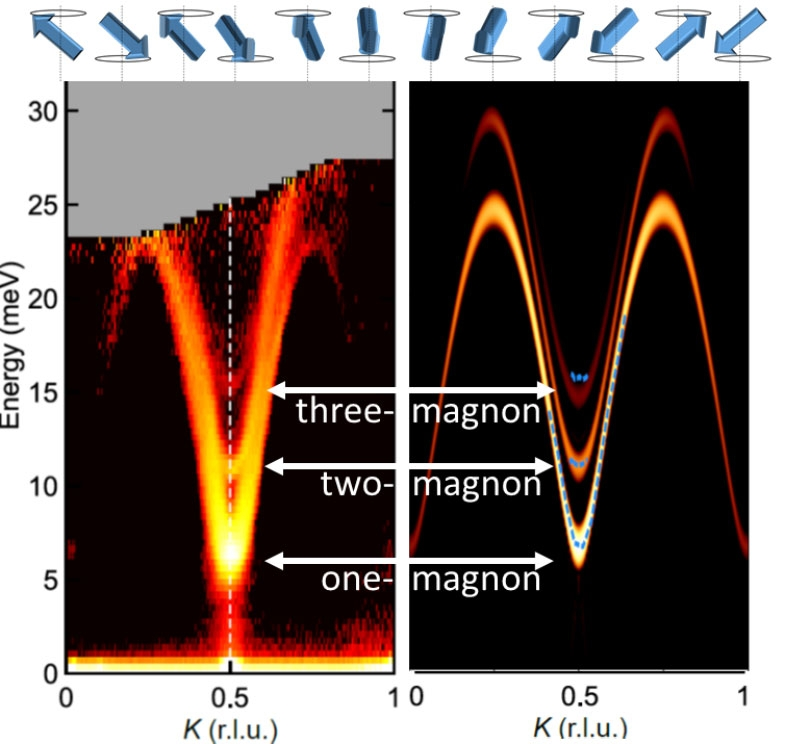Nov 5 2020
Researchers usually disturb materials and observe their responses to understand their behavior. A taut string’s tension can be understood by plucking it. Similarly, magnetism in materials can be investigated by analyzing the oscillations of the magnetic effects.
 Top: oscillating moments in a spin chain, forming a magnon. Bottom: neutron scattering data (left) and corresponding theoretical models (right) in sodium manganese oxide corresponding to one-, two-, and three-magnon bound states. Image Credit: Stephen Wilson and Rebecca Dally.
Top: oscillating moments in a spin chain, forming a magnon. Bottom: neutron scattering data (left) and corresponding theoretical models (right) in sodium manganese oxide corresponding to one-, two-, and three-magnon bound states. Image Credit: Stephen Wilson and Rebecca Dally.
The analysis of these magnetic oscillations, or “magnons,” enables describing the behavior of magnetic materials. It is also possible to treat magnons as interesting new particles (i.e. quasiparticles, or disturbances that act like particles).
For a long time, researchers have proposed that magnons have the potential to interact and merge to form new quasiparticles. At present, neutron scattering has helped researchers to identify these multiple-magnon “bound states” in real materials.
The Impact
Researchers propose that inter-magnon interactions lead to the formation of new three-magnon bound states. But, to date, they have not been able to view more than two magnons attached together in a real material. Due to this lack of observations, the occurrence of three-magnon bound states is highly questionable.
In this study, sodium manganese oxide was found to be the first antiferromagnetic (moments aligned antiparallel each other) material that features a three-magnon bound state. This shows that such quasiparticles are sufficiently stable to form.
For future quantum technologies, it is crucial to use multiple-magnon bound states as quantum information carriers, and this study offers a model material to analyze the formation and properties of these new quasiparticles.
Summary
The basis of the insights into quantum magnetism relies on models of one-dimensional magnetic chains. The properties of such chains can be predicted by using accurate analytical solutions, which renders them the perfect testbeds for basic models of functions of magnets.
One hypothesis of these models is that, in unique settings, oscillations of magnetic moments, or magnons, in chains can be considered as quasiparticles attracted to one another.
Researchers forecast that these magnons will attach together in much higher numbers, thereby forming new quasiparticles, and two-magnon bound states have earlier been observed in materials that include one-dimensional chains of spins.
Magnetic frustration within sodium manganese oxide, which is a layered antiferromagnetic material, makes the magnetism to be largely one-dimensional. This, in turn, makes it a propitious material in the search for new forms of magnon bound states.
The neutron scattering measurements performed as part of the new study show that a native three-magnon quasiparticle occurs in sodium manganese oxide. This paves a new path to test basic theories of interactions in one-dimensional antiferromagnets and to further the understanding of quantum magnetism.
The results of this study are applicable to experiments intended to look for similar quasiparticles in cold-atomic gases and to enable their use as quantum information carriers in future quantum technologies.
The Department of Energy Office of Science, Basic Energy Sciences financially supported the experimental and theoretical work. The study benefited from the use of the Spallation Neutron Source, a BES user facility run by Oak Ridge National Laboratory.
Journal Reference:
Dally, R. L., et al. (2020) Three-Magnon Bound State in the Quasi-One-Dimensional Antiferromagnet α-NaMnO2. Physical Review Letters. doi.org/10.1103/physrevlett.124.197203.